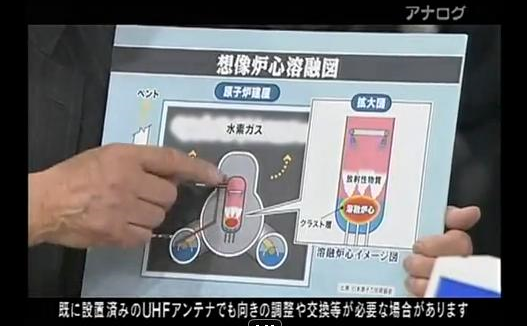Japan Nuclear Technology Institute expert: ‘The fuel rods are completely melted’
By arevamirpal::laprimavera
30 April 2011 More on 77-year-old Michio Ishikawa of the Japan Nuclear Technology Institute on the situation at Fukushima I Nuke Plant, as he appeared on Asahi TV on April 29. A Todai as-hole though he may be, I started to like this guy as I watched. He didn’t mince his words and said what they are doing at Fukushima I Nuke Plant is not working. That surprised some, including the host of the show, as Ishikawa is known as a strong proponent for the nuclear power generation and the nuclear industry. I watched the segment (video No.2 out of 11) where he discussed the situation at Fukushima I Nuke Plant, particularly about the condition of the reactor core. Here’s what I’d add to the snippets on my previous post. (My summary translation of what Mr. Ishikawa said, not literal; my comment in square bracket):“I believe the fuel rods are completely melted. They may already have escaped the pressure vessel. Yes, they say 55% or 30%, but I believe they are all melted down. When the fuel rods melt, they melt from the middle part on down. [Showing the diagram] “I think the temperature inside the melted core is 2000 degrees to 2000 and several hundred degrees Celsius. A crust has formed on the surface where the water hits. Decay heat is 2000 to 3000 kilowatts, and through the cracks on the crust the radioactive materials (mostly noble gas and iodine) are escaping into the air. “Volatile gas has almost all escaped from the reactor by now. “The water [inside the pressure vessel] is highly contaminated with uranium, plutonium, cesium, cobalt, in the concentration we’ve never seen before. “My old colleague contacted me and shared his calculation with me. At the decay heat of 2000 kilowatt. … There’s a substance called cobalt 60. Highly radioactive, needs 1 to 1.5 meter thick shields. It kills people at 1000 curies. He calculated that there are 10 million curies of cobalt-60 in the reactor core. If 10% of cobalt-60 in the core dissolve into water, it’s 1 million curies.”
[He’s an old-timer so he’s used to curie instead of becquerel as a unit. 1 curie equals 3.7 x 10^10 becquerels (37,000,000,000 becquerels or 37 gigabecquerels). 10 million curies equals 370,000 terabecquerels, and 1 million curies equals 37,000 terabecquerels. I used this conversion table. Tell me I’m wrong! Cobalt-60 alone would make a Level 7 disaster…] …
#Fukushima I Nuke Plant: Ishikawa of JNTI Talks about Reactor Core Conditions
